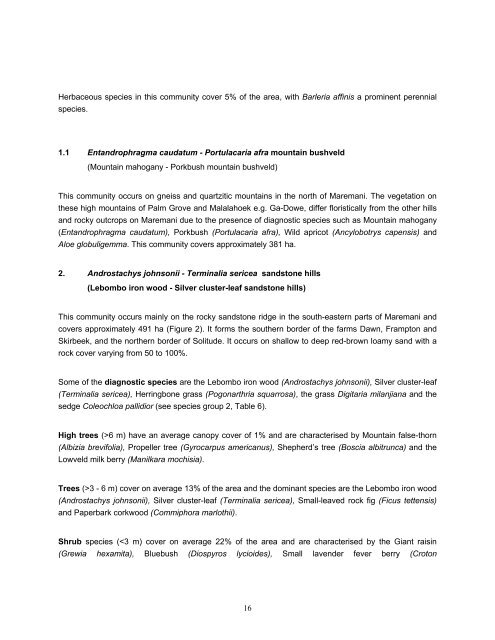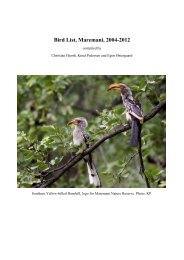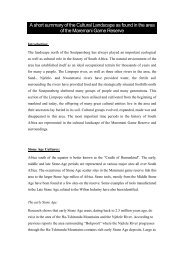the vegetation types and veld condition - Maremani Nature Reserve
the vegetation types and veld condition - Maremani Nature Reserve
the vegetation types and veld condition - Maremani Nature Reserve
You also want an ePaper? Increase the reach of your titles
YUMPU automatically turns print PDFs into web optimized ePapers that Google loves.
Herbaceous species in this community cover 5% of <strong>the</strong> area, with Barleria affinis a prominent perennial<br />
species.<br />
1.1 Ent<strong>and</strong>rophragma caudatum - Portulacaria afra mountain bush<strong>veld</strong><br />
(Mountain mahogany - Porkbush mountain bush<strong>veld</strong>)<br />
This community occurs on gneiss <strong>and</strong> quartzitic mountains in <strong>the</strong> north of <strong>Maremani</strong>. The <strong>vegetation</strong> on<br />
<strong>the</strong>se high mountains of Palm Grove <strong>and</strong> Malalahoek e.g. Ga-Dowe, differ floristically from <strong>the</strong> o<strong>the</strong>r hills<br />
<strong>and</strong> rocky outcrops on <strong>Maremani</strong> due to <strong>the</strong> presence of diagnostic species such as Mountain mahogany<br />
(Ent<strong>and</strong>rophragma caudatum), Porkbush (Portulacaria afra), Wild apricot (Ancylobotrys capensis) <strong>and</strong><br />
Aloe globuligemma. This community covers approximately 381 ha.<br />
2. Androstachys johnsonii - Terminalia sericea s<strong>and</strong>stone hills<br />
(Lebombo iron wood - Silver cluster-leaf s<strong>and</strong>stone hills)<br />
This community occurs mainly on <strong>the</strong> rocky s<strong>and</strong>stone ridge in <strong>the</strong> south-eastern parts of <strong>Maremani</strong> <strong>and</strong><br />
covers approximately 491 ha (Figure 2). It forms <strong>the</strong> sou<strong>the</strong>rn border of <strong>the</strong> farms Dawn, Frampton <strong>and</strong><br />
Skirbeek, <strong>and</strong> <strong>the</strong> nor<strong>the</strong>rn border of Solitude. It occurs on shallow to deep red-brown loamy s<strong>and</strong> with a<br />
rock cover varying from 50 to 100%.<br />
Some of <strong>the</strong> diagnostic species are <strong>the</strong> Lebombo iron wood (Androstachys johnsonii), Silver cluster-leaf<br />
(Terminalia sericea), Herringbone grass (Pogonarthria squarrosa), <strong>the</strong> grass Digitaria milanjiana <strong>and</strong> <strong>the</strong><br />
sedge Coleochloa pallidior (see species group 2, Table 6).<br />
High trees (>6 m) have an average canopy cover of 1% <strong>and</strong> are characterised by Mountain false-thorn<br />
(Albizia brevifolia), Propeller tree (Gyrocarpus americanus), Shepherd’s tree (Boscia albitrunca) <strong>and</strong> <strong>the</strong><br />
Low<strong>veld</strong> milk berry (Manilkara mochisia).<br />
Trees (>3 - 6 m) cover on average 13% of <strong>the</strong> area <strong>and</strong> <strong>the</strong> dominant species are <strong>the</strong> Lebombo iron wood<br />
(Androstachys johnsonii), Silver cluster-leaf (Terminalia sericea), Small-leaved rock fig (Ficus tettensis)<br />
<strong>and</strong> Paperbark corkwood (Commiphora marlothii).<br />
Shrub species (




